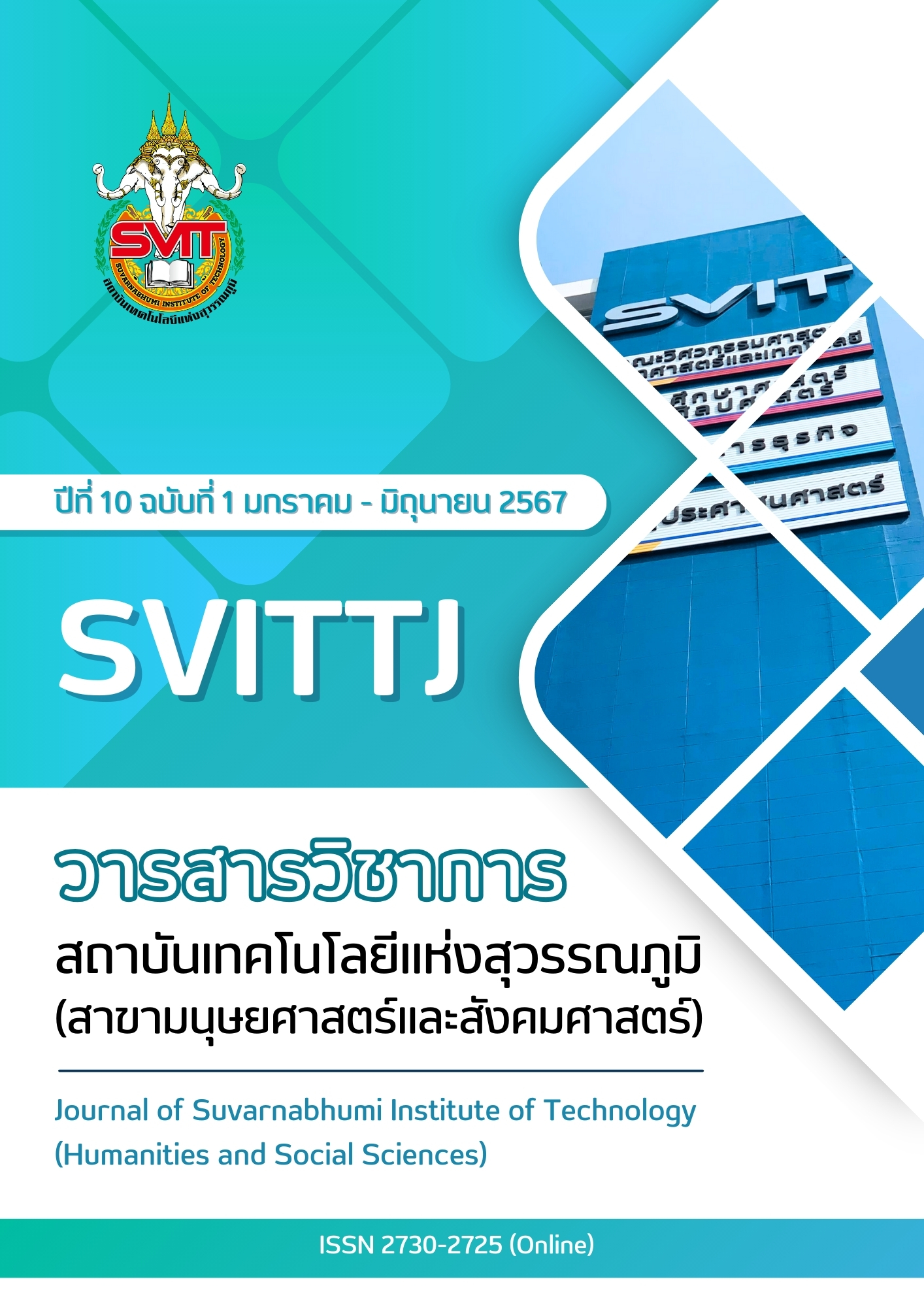CREATING AN IMPRESSIVE EXPERIENCE FOR CHINESE CUSTOMERS TO MAKE THEM DECIDE TO BUY USING SALES COMMUNICATION CHANNELS ON THE ALIPAY AND WE CHAT APPLICATIONS IN CHINESE
Keywords:
Impressive Experience, Decide to Buy, AliPay, We ChatAbstract
Chinese tourists are considered the main customer group that helps drive and drivethe Tourism market in Thailand to grow significantly. The most popular products are products processed from Thai fabric or Thai handicraft products. Creating an impressive experience for Chinese customers to make them buy products. It is one way to increase the opportunity to generate business income for entrepreneurs who can adapt quickly. Including the ability to choose appropriate channels for approaching customers to provide information and guidelines for entrepreneurs to improve and organize souvenir shops, that can meet the real needs of Chinese tourists. By developing new methods for reaching more groups of service recipients. Many stores try to increase the sought to enhance the customer's experience of their brands to differentiate themselves from competitors that offer similar products and services. The strategies that are used to create a good experience for customers, it create a good image for buyers. By creating the impression that customers will receive from the brand. Whether the employees communicate in Chinese, Including using the AliPay and We Chat applications. They are platforms that are popular with Chinese tourists as communication channels for online purchases and convenient and fast payment methods. This characteristic is alike a one-stop shop. That helps impress customers and can answer the needs of travelling in Thailand. It affects the feelings and decisions of customers about returning to use the Thai fabric processed products business again. Including attracting more purchasing decisions from new customers in the future.
References
กระทรวงการท่องเที่ยวและกีฬา. (2562). สถิติการท่องเที่ยว. สืบค้นจาก https://mots.go.th/more_news_new.php?cid=411
กระทรวงการท่องเที่ยวและกีฬา. (2566). สถิตินักท่องเที่ยวชาวต่างชาติที่เดินทางเข้าประเทศไทย ปี 2566 (จำนวนยอดสะสมเบื้องต้น มกราคม-มิถุนายน 2566). สืบค้นจากhttps://mots.go.th/news/category/707
การตลาดจีน levelupthailand. (2566). Alipay และ WeChat Pay ทำไมต้องใช้การตลาดจีน ยุคดิจิทัล. สืบค้นจาก https://www.levelupthailand.com/post/alipay-wechat-pay-china-marketing-thai
เกรียงศักดิ์ เจริญวงศ์ศักดิ์. (2561). อิทธิพลของนักท่องเที่ยวจีนต่อเศรษฐกิจไทย. สืบค้นจาก https://www.bangkokbiznews.com/blog/detail/645188
กวินวัฒน์ หิรัญบูรณะ. (2559). พัฒนาการธุรกิจเสื้อผ้าสำเร็จรูป ทศวรรษที่ 2510-2530. (วิทยานิพนธ์ปริญญาหาบัณฑิต, มหาวิทยาลัยธรรมศาสตร์).
ไข่มุกด์ วิกรัยศักดา และเฉลิมชัย กิตติศักดิ์นาวิน. (2562). ความสำคัญของประสบการณ์ลูกค้าในธุรกิจบริการการสร้างความได้เปรียบ ในการแข่งขันทางการตลาดในโลกอนาคต. Veridian E-Journal, Silpakorn University: Humanities, Social Sciences and arts, 12(2), 537–554.
ชวัลรัตน์ บัวคำป้อ. (2563). อิทธิพลของการสื่อสารการตลาดดั้งเดิมและการสื่อสารการตลาดผ่านสื่อออนไลน์ต่อระดับคุณค่าตราสินค้าธุรกิจค้าปลีกสมัยใหม่ประเภทร้านสะดวกซื้อในมุมมองของผู้บริโภคเขตภาคตะวันออก. (วิทยานิพนธ์ปริญญามหาบัณฑิต, มหาวิทยาลัยบูรพา)
ตรีเพ็ชร์ อ่ำเมือง. (2566). คู่มือ-เทคนิคการให้บริการด้วยใจ “Service Mind”. งานเลขานุการกิจและสภาคณาจารย์ กองบริหารงานทั่วไป สํานักงานอธิการบดี มหาวิทยาลัยมหิดล.
ฐิญาภา เสถียรคมสรไกร และ พิมพ์สิรี สุวรรณ. (2566). การพัฒนาผลิตภัณฑ์ของที่ระลึกของการท่องเที่ยวด้วยนวัตกรรมเพื่อการสร้างมูลค่าเพิ่มแก่ทรัพยากรท้องถิ่น. Journal of Roi Kaensarn Academi, 8(20), 411-432.
นิติธร ครุทบางยาง. (2561). การศึกษาเชิงเปรียบเทียบพฤติกรรมการซื้อสินค้าของนักท่องเที่ยวชาวยุโรปและชาวจีน. (วิทยานิพนธ์ปริญญามหาบัณฑิต, สถาบันบัณฑิตพัฒนบริหารศาสตร์)
ประสพโชค มั่งสวัสดิ์. (2559). ระบบทุนนิยมที่เอื้อเฟื้อต่อกัน : สิ่งที่มุ่งหวังและเป็นจริงได้. สืบค้นจาก http://www.thansettakij.com/content/85167
พจน์ธรรม ณรงค์วิทย์ และอำไพ แสงจันทร์ไทย. (2561), การออกแบบและพัฒนาผลิตภัณฑ์กระเป๋าสำหรับ สุภาพสตรีจากผ้าฝ้ายย้อมสีธรรมชาติ กลุ่มทอผ้าฝ้ายย้อมสีธรรมชาติไหมแก้วพัฒนา จังหวัดกำแพงเพชร. สักทอง: วารสารมนุษยศาสตร์และสังคมศาสตร์ (สทมส.), 24(2), 119-134.
ภาวุธ พงษ์วิทยภานุ. (2561). มอง Super App ในประเทศไทย. สืบค้นจาก https://pawoot.wordpress.com/2017/11/05/open-wechatpay/
เลิศพร ภาระสกุล. (2559). พฤติกรรมนักท่องเที่ยว. กรุงเทพฯ: โรงพิมพ์จุฬาลงกรณ์มหาวิทยาลัย.
วัชรวิชญ์ วิยาภรณ์. (2563a). แนวทางการพัฒนาพัทยาสู่เมืองแห่งการท่องเที่ยวแบบจับจ่ายใช้สอยอย่างยั่งยืนของนักท่องเที่ยวชาวจีนแผ่นดินใหญ่. วารสารวิจัยราชภัฏเชียงใหม่, 21(3), 228-249.
ศูนย์ส่งเสริมศิลปาชีพระหว่างประเทศ (องค์การมหาชน). (2558). พฤติกรรมการใช้จ่ายของนักท่องเที่ยวต่างชาติในการซื้อสินค้างานหัตถกรรม. รายงานประจำปี 2558-2559.
สุกานดา ถิ่นฐาน (2562). ปัจจัยที่มีผลต่อการพฤติกรรมการตัดสินใจซื้อสินค้างานหัตถกรรมของนักท่องเที่ยวในสถานที่ท่องเที่ยวกรณีศึกษา เมืองมัลลิกา ร.ศ.124 จังหวดกาญจนบุรี. (วิทยานิพนธ์ปริญญามหาบัณฑิต วิทยาลัยการจัดการ มหาวิทยาลัยมหิดล).
สุคนธ์ทิพย์ วงศ์พันธ์และ ศรีสุดา อัฏฏะวัชระ. (2566). การประยุกต์ใช้แนวคิดห่วงโซ่คุณค่า การใช้ประโยชน์และความแตกต่างด้านการขายสินค้าระหว่างการใช้เทคโนโลยีสารสนเทศและการสื่อสารสังคม, วารสารกองทุนพัฒนาสื่อปลอดภัยและสร้างสรรค์, 2(4), 85-114
สํานักข่าวมติชนออนไลน์. (2561). ของฝากนักช้อป เจาะตลาด ‘ไทยโปรดักซ์’ ที่สุดสินค้ายอดนิยม ‘คนจีน’นิยมหิ้ว. สืบค้นจาก https://www.matichon.co.th/lifestyle/news_1235052
สหัสวรรษ ปันทา. (2554). ปัจจัยที่มีผลต่อการตัดสินใจเลือกซื้อผลิตภัณฑ์แปรรูปจากผ้าฝ้ายทอมือในอำเภอสันกำแพง จังหวัดเชียงใหม่. (วิทยานิพนธ์ปริญญามหาบัณฑิต, มหาวิทยาลัยแม่โจ้).
อิทธิชัย อรรถกระวีสุนทร. (2563). นักท่องเที่ยวจีนกลุ่ม FIT ทําไมถึงสําคัญกับการท่องเที่ยวไทย. สืบค้นจาก https://www.bangkokbiznews.com/blog/detail/649407
เหมือนแพร กุสสลานุภาพ. (2564). แผนธุรกิจผลิตภัณฑ์เสื้อผ้าเครื่องน่งห่มทอมือเส้นใยฝ้ายธรรมชาติแบรนด์‘ดิน’ (DIN). (วิทยานิพนธ์ปริญญามหาบัณฑิต, มหาวิทยาลัยมหิดล)
อภิรดี สราญรมย์. (2565). คุณภาพการให้บริการส่งผลต่อความจงรักภักดีของผู้บริโภคในการรับบริการสเตเคชั่น. วารสารสหวิทยาการมนุษยศาสตร์และสังคมศาสตร์, 5(4), 1740–1754.
Berry, L. L., Seiders, K., Grewal., (2002). Understanding service convenience. Journal of Marketing, 66, 1 – 17.
Bygate, Martin. (1991). Speaking: Language Teaching, a Scheme for Teacher Education. Oxford: Oxford University Press.
Chanin Yoopetch. (2017). The determinants of souvenir shopping satisfaction of international tourists. Panyapiwat Journal, 9, 1-13.
Kim, Y., Park, Y., & Choi, J. (2017). A study on the adoption of IoT smart home service: using
Value-based Adoption Model. Total Quality Management and Business Excellence, 28 (9-10), 1149-1165
Li Xin. (2563). พฤติกรรมการใช้แอพพลิเคชัน AliPay ของชาวจีนอาศัยอยู่ในกรุงเทพมหานครในช่วงการเกิด COVID-19. (วิทยานิพนธ์บริหารธุรกิจมหาบัณฑิต, มหาวิทยาลัยธุรกิจบัณฑิต).
Mellow yellow. (2558). นักท่องเที่ยวชาวจีน ศักยภาพที่ไทยต้องจับตามอง. สืบค้นจาก https://www.marketingoops.com/reports/high-value-chinese-tourist/
Prosoft (2566). เทคนิคการขายให้ลูกค้าประทับใจทำให้ลูกค้ากลับมาซื้อซ้ำ. สืบค้นจากhttps://www.prosoft.co.th/Article/Detail/121830/
blog. 6 วิธีสร้าง Customer Experience ที่ดีตั้งแต่ต้นน้ำยันปลายน้ำให้ธุรกิจของคุณ. สืบค้นจาก https://blog.readyplanet.com/17787525/6-ways-to-create-a-good-customer- experience
Santouridis, I., & Veraki, A. (2017). Customer relationship management and customer satisfaction: the mediating role of relationship quality. Total Quality Management & Business Excellence, 1-12.
Downloads
Published
Issue
Section
License
Copyright (c) 2024 Suvarnabhumi Institute of Technology

This work is licensed under a Creative Commons Attribution-NonCommercial-NoDerivatives 4.0 International License.
บทความที่ได้รับการตีพิมพ์เป็นลิขสิทธิ์ของวารสารวิชาการ สถาบันเทคโนโลยีแห่งสุวรรณภูมิ
ข้อความที่ปรากฏในบทความแต่ละเรื่องในวารสารวิชาการเล่มนี้เป็นความคิดเห็นส่วนตัวของผู้เขียนแต่ละท่านไม่เกี่ยวข้องกับสถาบันเทคโนโลยีแห่งสุวรรณภูมิ และคณาจารย์ท่านอื่นๆในสถาบันฯ แต่อย่างใด ความรับผิดชอบองค์ประกอบทั้งหมดของบทความแต่ละเรื่องเป็นของผู้เขียนแต่ละท่าน หากมีความผิดพลาดใดๆ ผู้เขียนแต่ละท่านจะรับผิดชอบบทความของตนเองแต่ผู้เดียว





